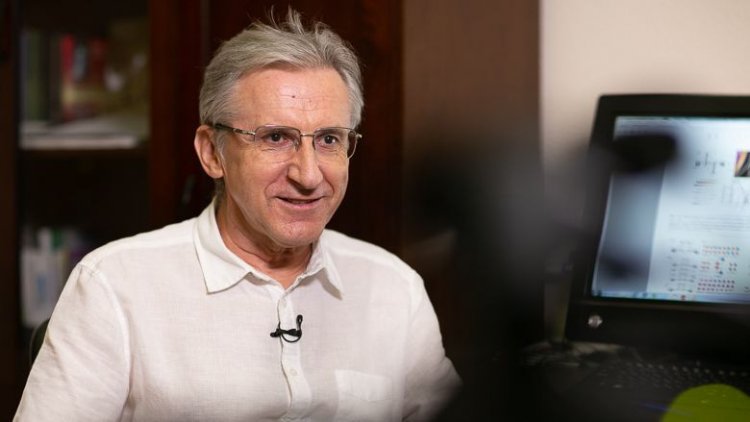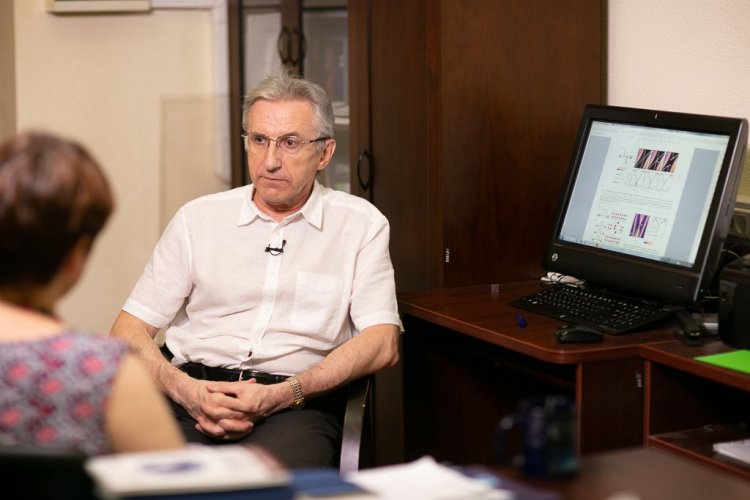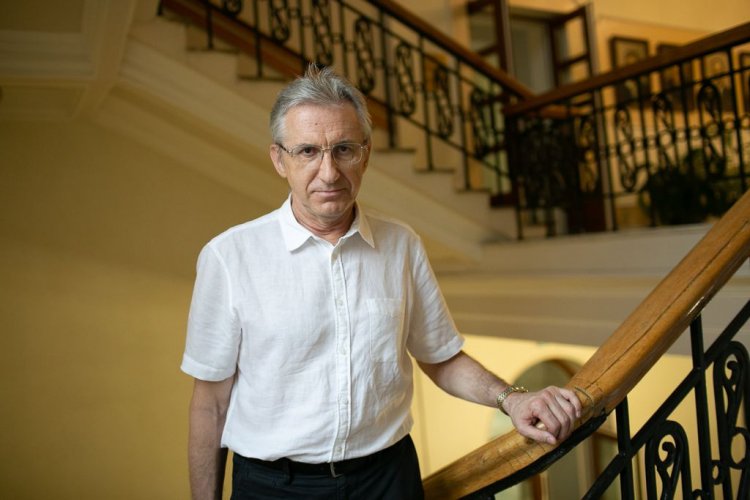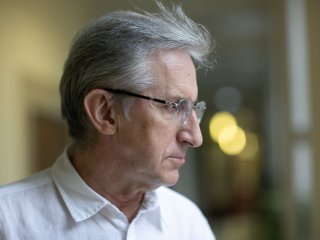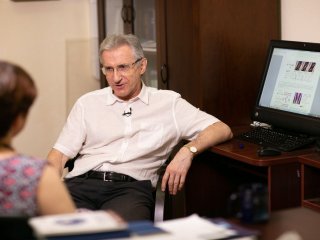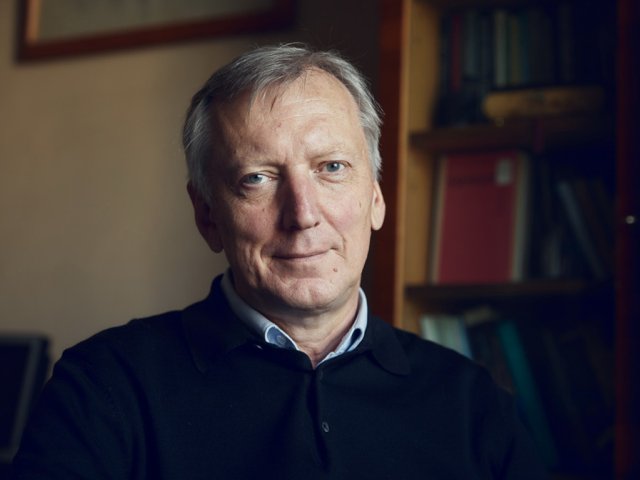Can our computers be made more powerful, and what solutions can be used for it? When will quantum computer appear? What has Schrodinger’s cat, which is dead and alive at the same time, to do with it? Aleksandr Gorbatsevich, Chief Research Fellow at the Physics Institute of the Russian Academy of Sciences (RAS), head of Laboratory for Quantum Design of Molecular and Solid-State Nanostructures, head of Quantum Physics and Nanoelectronics Department at Moscow Electronic Equipment Institute (MIET), RAS academician, reflects on quantum system modeling.
- So, Aleksandr Alekseyevich, we talk about quantum modeling of solid-state nanostructures. What is it?
– Quantum modeling means solving equations of quantum mechanics. Schrodinger’s equation is being solved for some object that may be interesting to us. Dealing with fundamental science, we take interest in any objects that promise to us something new, something yet unknown that can expand the limits of knowledge.
– What objects do you study today, for instance?
– Now, we study quantum transistors, which can result in radical changes in information structure of our society related to information processing. Actually, the basis for modern information technologies is formed by material data-bearing media, or element base, as we call them. Historically, we face objective tasks and hope to accomplish them with the help of fundamental research. We have come to this area from fundamental physics and continue to deal with the theory of open quantum systems. As for new regularities that we manage to find and describe within the framework of this theory, we try to turn them into practical applications.
– Do you succeed?
– We do, though it is not yet clear, whether the way to smartphones and gadgets for everyone has been completed. The situation is changing every year, like the assessments and forecasts, yet the fact is that we have obtained extremely interesting results, which, from our point of view, will be very important for next generations of researchers.
– What results have you already obtained?
– We started with studying fundamental regularities in behavior of open quantum systems. However, if there are open quantum systems, there should be closed ones. Closed quantum systems are the objects that the standard training course in quantum mechanics studies. An atom, say, is a good example of a closed quantum system, though it naturally interacts with the environment. We view it as a closed quantum system to understand its main properties.
Quantum mechanics is based on two main principles – superposition principle and Heisenberg uncertainty relation. The superposition principle is about quantum systems being not only in one state, but the other one as well. This idea has become accessible today and very popular among public at large with regard to the well-known problem of cubits, quantum bits, and quantum computer.
Everybody looks forward to a miracle in the field of information systems related to using new opportunities of quantum mechanics and creating a quantum computer on this basis. This very opportunity is based on the superposition principle. I.e., an object can be not only in a certain state, but in two states simultaneously.
– Like Schrodinger’s cat?
– You are right. Teleportation is about this very topic.
– One immediately starts thinking whether we can be in several variants of some dimension. I.e., we are talking with you in one dimension, and have never met in the other one.
– It is a bit different thing, though also about quantum mechanics. It is the so-called multiworld interpretation of quantum mechanics that is far enough from our everyday experience and common sense as we understand it. The discrepancy between the laws of quantum mechanics and everyday experience served as a basis for well-known polemics between Einstein and the founders of quantum mechanics. As for multiworld interpretation of quantum mechanics, young American physicist Hugh Everett paid attention to the fact that such idea does not formally contradict science. There may really be several universes that are parallel to each other.
– They do not intercross, so we do not know about them.
– Yes, they do not intercross. This bright and spectacular idea has immediately entered the culture, literature and cinematography and led to the publication of popular novels, which have been translated into Russian. I mean The Chronicles of Amber by Roger Zelazny and many others.
– Let us come back to science…
– The thing that we have been talking about cannot be verified so far. It is an artistic image that has inspired many fundamental and important discoveries. As for superposition, this effect can be verified. It is a reliable, yet also non-classic one.
It means that if there is a chance for a particle to travel from the starting point to the end point following one way and another, probability amplitude is formed at the end point with phase playing an important role in the process. It may result in the probability of reaching the end point being equal to zero. This is the phenomenon of interference related to superposition of various states and ways. Here, the particle behaves like a wave. Everybody knows that waves can interfere. Thus, we get the ripple, loop of the wave, or the minimum of wave. Material objects can also behave likewise. It is the first thread that one may use to drag out something new and useful.
– What is required to build electronic devices on the basis of this principle?
– In order to observe interference, the device size should be very small, comparable with the electron’s wave length, i.e., dozens of angstroms maximum. It is the size of a molecule, and fundamentally the one of instruments and devices produced by traditional methods of modern micro– and nanoelectronics. It is the method of lithography, which progresses under the flag of Atomic Precision Lithography. When this device is worked out, we will be able to draw all these trajectories.
However, such objects exist in nature nowadays. I mean molecular structures where the phenomenon of interference takes place. It is actively studied, yet at the very initial level.
The second moment is about the second principle of quantum mechanics, which the students know from the basic course of physics. The concluding section of basic physics is nuclear physics, and the elements of quantum mechanics are present in it.
I mean the Heisenberg uncertainty principle. You cannot localize the particle arbitrarily closely and identify its energy, as the uncertainty of coordinate exists. The most fundamental formulation is the uncertainty of coordinate multiplied by the uncertainty of impulse. The minimum value that the product of these two uncertainties may be equal to is Planck constant.
– So, a sort of constancy is formed by uncertainties, isn’t it?
– A sort of atomic structure constancy is formed up. We know about discrete levels in atoms. From the chemistry course we know S state, P state and D state. S state is a ball, while P state refers to the dumb-bell shape. Even this data is enough to explain many things. The silicon that forms of basis of electronics, all electrons are in the so-called hybridized state, i.e., sp3. All wave functions and chemical bonds are directed towards the tetrahedron’s summit. As far as carbon is concerned, various configurations are possible. If the shape is the one of silicon, we will get a diamond. Or we may have sp2 configuration with not all of the orbitals being entangled, as they are related in plane. Then, it will be graphite. If we split the graphite, one of the layers will be graphene that has been awarded with a Nobel Prize and serves as a basis for producing a whole class of new materials. It is science-fiction, yet true to life one.
– Is it close to the subject you study?
– It is, yet not the very thing we study. We have talked about the carbon and discrete levels, when electron may be on the level of S state, P state, etc. Why are the levels discrete? The electron that is moving in free space can change its energy all the time. The energy is the squared impulse, or squared velocity. It is linked to uncertainty relations and the fact that the electron is localized inside the atom, sort of trapped. It interacts with the nucleus, and this very interaction energy limits the space accessible for it. It is inside the atom.
It means that there is maximum value of uncertainty to this coordinate. I.e., the electron is localized and cannot move far away. However, it arises from the uncertainty relation that there is minimum interrelation and minimum impulse uncertainty, which is inversely proportional to this uncertainty.
If there is some impulse uncertainty, we mark out the energy state. This is how the discrete spectrum appears. That is the way we have found some behavior patterns of open quantum systems. These characteristics constitute interference that has started playing a more important part at the state of designing specific devices. As for the phenomenon that we have discovered, it can be formulated as a relation of uncertainties, the so-called size quantization.
– Is it right that you have discovered the properties of open quantum systems?
– Yes, while the property of closed quantum systems for the same atom was discovered by Heisenberg. We have discovered the reverse property. Now, if we open the quantum system by some method, make it interact with the environment, it will be possible to create something similar to such systems that interact with the environment. If your particle is in this space for some limited period of time and then leaves it due to interaction with the environment, it means that the level of its energy can be identified only with the accuracy inversely proportional to the period of this particle’s life.
The atomic decomposition can serve as an example of this phenomenon. It is one of the first problems of quantum mechanics showing how quantum mechanics explains the world around us and nuclear decomposition. This problem was solved by George Gamow (Georgy Gamov), our compatriot.
As for our observation, we took a quantum system, open and complicated enough, with energy levels being uncertain due to interaction with the environment. It may be a molecule that interacts with contacts. The electrons enter the molecule from the contacts and go away from it to the contacts too. It is a typical system, an example of open quantum one. Isolated molecule possesses discrete spectrum. Now, if the probability of going away from the molecule to the contact or coming to the contact becomes possible for an electron, the life period becomes limited, while all levels of energy split and expand. Another example is about hetero-structures. Modelling hetero-structures, we have come across this phenomenon: if we connect it to the contacts, the levels acquire finite width. How can it be verified? It can be verified by way of calculating the quantum-mechanical transparency of such structure.
The energy level for open quantum system that we calculate transparency for turns into the resonance, transit peak. We have seen that these resonances may behave in an unexpected fashion – two resonances come close to each other, merge and then vanish.
– Do they compensate for each other?
– Well, something like this happens. It has turned out that there is a mathematically described phenomenon – inverse size quantization. What does it mean? It means that if two levels with finite width come close to each other in your system, you can change parameters in this way. If only one quantum well is taken, it will not work out. You will never bring two levels of finite width close enough to each other. Nevertheless, if you bring the levels of finite width so close to each other that they start overlapping, intercrossing, it will be impossible to mark them out due to the change in the system parameters. They are to merge into one level.
However, as you have a system, it means that one level may be symmetrical, while the other one – asymmetrical. Depending upon the arrangement of interaction with environment – whether the electron comes from the right or left – this asymmetry will exist in an initially symmetrical system. Changing the nature of interaction with environment, you change the nature of this asymmetry. This is a fundamental property of open quantum systems.
It means that the transparency of the system will drop down. If you bring a transparent quantum system into the situation with this effect of reverse size quantization, it becomes nontransparent. This phenomenon can be used in instruments.
– In what way?
– The fact is that this property is fundamental, mathematical. The main equation is Schrodinger’s one, so classical values in quantum mechanics are replaced by operators, while the main characteristic of classic energy particle in quantum mechanics becomes an energy operator – a Hamiltonian. If we take an open quantum system, it can also be described in the Hamiltonian language, yet it is a certain unsymmetrical matrix. It is the field where we can partially demonstrate our art of molecular design.
– What molecular systems have you learned to create, and what makes them so good?
–These are complicated molecular systems with various trajectories for the movement of electrons. They are good because, they can be switched over from high-conductivity, high-transparency state to low-transparency one by way of some external effect, some potential. The properties change immediately in this case. This discovery resulted from the research of fundamental processes. It has turned out that when we apply this science to molecular structures, an opportunity appears to switch over, to control the quantum-mechanical transparency, which actually determines the conductivity of our system.
– What is switching-over required for?
– This switching-over is required, because the whole element base of information technologies functions as keys. Transistor is a key. It is like a water tap. You open the tap, and the electrons start flowing. You close it, and electrons stop flowing. Naturally, the voltage at the input and output is changing. This water tap is controlled with the help of voltage which is transmitted from the previous gate, or valve. I mean the valve that can be toggled. What do we need all that for?
Any person dealing with a computer or smartphone must have wondered why the frequency remains the same. You might notice that frequencies of processors have reached two, three, four GHz, and stopped rising. It is the problem of energy consumption. Modern processors – modern element base – started consuming a lot of energy. Why? It is because every switchover of the transistor requires energy.
What does transistor switchover mean? The main element base includes transistors, metal-oxide-semiconductor (MOS). We form the channel that the electrons use to move, or, on the contrary, we close this channel. What is this channel? It is a certain potential relief that the electrons come into. Or, if we raise the potential energy, the electrons flow out of it, and our transistor stops conducting.
We must change the voltage to raise or drop the potential of this relief. Naturally, we see the flow-over of charges. The change in voltage leads to change in potential and movement of charges. This process requires energy. Fundamentally, modern processors have come to the level of rocket motor nozzle, if we make calculation in terms of area units. It is a thermonuclear reactor. In this case natural restriction to material comes into action.
Silicon that all our information technologies are based on has its own parameters. Here, we can recall forbidden bandwidth and switchover mechanism. At the moment of switchover, the electrons hurdle this barrier with some certainty. It is a law of nature. Therefore, the value is 0.5 volt for modern transistors. It is impossible to obtain a lower value.
– Can you solve this problem in some way?
– Yes. Naturally, people have thought about it for a long time. Various solutions have been proposed, yet not too many of them. There are two main areas here. We should build something into the system to make it switch over on its own like a phase transfer. I.e., we need to push it slightly, create a sort of disposition toward, potential instability for the transition into a different state. To do that, the system or some of its elements ought to be well-aligned. These are the so-called transistors with negative capacitance.
There are such materials as ferroelectrics with polarization being characteristic of them. The positive and negative charges are spaced in them, and they have in-built internal fields. This polarization is the intrinsic property of material interaction. Moreover, it makes no difference for the material, whether the direction of this polarization is positive or negative, while the charges on its edges undergo substantial changes.
The second variant lies in changing the mechanism, building a key into it. It means that the system realigns on its own due to having internal instability, and we do not have to realign it. For that, we ought to change the mechanism of current passage.
– How can it be done?
– For instance, we can make a barrier with tunneling to the conductivity zone from the contact. Each of these two areas has its own strengths and weaknesses. Our approach brings these two phenomena together. We use the tunnel current passage mechanism with the opportunity of interference tunneling along different ways. Besides, we have no restriction related to forbidden zone, as the internal electronic phase transfer is built into the system.
– Do you have a standard PC on your desk, or the one with all these new capacities?
– No, I use a standard PC so far. Yet, we are trying to come to a new level of practical use. Our article will soon come out in Chemical Physics, which is a high-status magazine for publishing theoretical works. We have a scholar paper prepared for printing. It describes similar effects in electromagnetic wave guides for optical communication systems.
– Aleksandr Alekseyevich, what would be the difference between this computer and traditional one?
– It is a classic PC, not a quantum machine. However, it seems to me that we have come forward with our idea in time from the viewpoint of cognitive process complementing many ideas of quantum computer. The main problem of quantum computer that kills all attempts to produce serious devices lies in the one of de-coherence, destruction of coherence. The principle of superposition that we have talked about should be complied with for a long enough time. However, the variety of interactions with environment destroys this coherence. Thus, the superposition is interrupted bringing in an element of chaos. We are overcoming this problem.
– How?
– We have shown that even the strong interaction between quantum systems and environment can serve a good cause. Exceptional points may appear – the analogs of phase transfer.
– What practical advantages will result from it?
– We get minimum 5 instead of 0.5 volts. The frequencies will rise from 2 to 20 and more GHz. You will not have to wait for the Internet to load up. It will load up in an instance. If it works out, we will feel the improvement immediately. It will be a breakthrough in information technologies.
However, life is not easy, and we have to take into account economic aspects, the readiness of our economy. It looks that nothing will happen before 2030, as the decision regarding the development of nanoelectronics for the period to 2030 has been made already. At that time the resource of the present technologies will be exhausted, and the door will be open for new materials and physical principles.
– You mean that we are waiting for the resources to exhaust as usual, don’t you?
– Alas, it is so. However, it is good news, as it means that the gadgets will become increasingly better without any revolution, though the process is not going to be quick. Along with consumer qualities, price also plays an important role.
A window of new opportunities is to open after 2030. I hope that we will reach this date fully armed apart from satisfying our research curiosity.
Interviewer: Natalia Leskova
Photo: Andrey Luft/Scientific Russia
